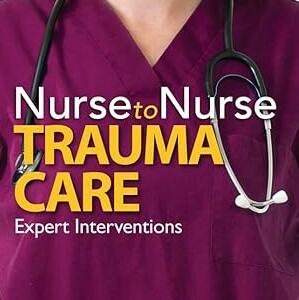 In my experience, if there is one thing novice nurses need to get a firm handle on in trauma care, it is the triage process. Triage is not only assessing who to treat first, but also making thoughtful, quick decisions that can save lives.
In my experience, if there is one thing novice nurses need to get a firm handle on in trauma care, it is the triage process. Triage is not only assessing who to treat first, but also making thoughtful, quick decisions that can save lives.
The basic trauma care is the ABCs – airway, breathing, and circulation. These three elements are the vital signs of life, and they need to be your first port of call in a trauma situation. It is the foundation; without a solid foundation, everything else could fall apart.
Prioritizing care is also crucial and you will get better at with time. You will use triage protocols to determine the severity of injuries and decide on the spot who needs your attention the most. I cannot underscore enough how important it is to stay calm and focused during this step, patients’ lives depend on it.
The below content will comprise some scenarios that will help you understand the nuances of triage. Picture this: a patient comes in after a car accident. You notice they are conscious but struggling to breathe. Your ABC assessment tells you their airway might be compromised. This is where your training applied – you respond rapidly to clear the obstruction, all while signaling to your team that this patient is a priority. Scenarios like this will test your skills and help you develop the confidence you need in the chaos of trauma care.
Once you have got a grasp on the essentials of assessment and triage, let’s delve into what comes next: stabilization. This goes beyond assessment; it involves intervention and ensuring that your triage skills as the foundation – stands strong through the next wave of challenges.
Stabilization: The Foundation of Effective Trauma Response
After a thorough triage process, stabilization is your next critical task. This is where you will put all that knowledge about airway, breathing, and circulation into practice. Let’s look at some of those non-negotiables in trauma care stabilization.
Starting with the airway, you are going to clear any obstructions and ensure the patient’s head is in recovery positioned so that breathing is not compromised. This is not only propping up a pillow, but also knowing anatomy and how to prevent a compromised airway.
Speaking of breathing, in some cases, supplying additional oxygen can make all the difference. You will need to know when to step in with ventilatory support, and that means understanding the signs of respiratory distress deeply.
Then there is bleeding, which can be stealthy and deadly. Control is critical, and direct pressure is your first go-to method. But when direct pressure is not enough, knowing how to properly apply a tourniquet can save a life. We will cover both of these techniques, ensuring you are prepared for these urgent situations.
Vigilant Monitoring and Emergency Interventions

You are going to find out about the critical role that vigilant monitoring plays in the care of trauma patients. Regular checks of heart rate, blood pressure, respiratory rate, and oxygen saturation provide a dynamic picture of a patient’s condition, acting as your compass through the unpredictable terrain of trauma care. Detecting early signs of deterioration is key, and you will be guided through understanding these vital parameters.
Now what is an essential capacity for any nurse handling emergencies? It is the ability to perform life-saving emergency procedures. In my opinion, you need to have a solid grasp on CPR and defibrillation, as these are cornerstones of basic life support that can mean the difference between life and death. We will delve into the concepts and practical aspects that will bolster your confidence.
Effective communication — it is not only passing on information, but also ensuring it is done so with precision and clarity to support the patient’s continuity of care. In trauma situations, this means concise and accurate reporting during handoffs and updates. A lot is happening very quickly, and there is no room for ambiguity. I am here to help you with the best practices in communicating effectively within the healthcare team.
Beyond the Basics: Empathy, Self-care, and Continuous Learning
We are going to wrap up our deep dive into trauma care basics, but our conversation does not end there. This is not only mastering technical skills, but also about embracing the humanness at the heart of nursing. You are going to find out that providing psychosocial support is not just beneficial for patients and their families—it is vital. Trauma does not just leave physical scars, and your role in offering comfort can be as healing as any medicine.
In my opinion, documenting your patient care is as crucial as the care itself. Document assessment findings, interventions, and patients’ responses meticulously. Accurate and timely records ensure continuity of care and are a resource in a high-stakes environment. Think of it as leaving a roadmap for those who are coming after you—it is got to be clear and reliable.
Learning is a long journey. Choose a path of continuous education, which means taking every chance you get to learn and improve. Training in Advanced Trauma Life Support and seeking trauma nursing certification are not just resume boosters—they are tools to save lives. The wisdom you will gain through ongoing education will bolster your confidence exponentially.
Teamwork is not just a buzzword; collaboration is your lifeline in the frenzied world of healthcare. When you work alongside physicians, surgeons, and other professionals, you are part of a collective force that can take on any challenge. Share knowledge, ask for advice, and never forget that everyone has something to offer.
Lastly, regarding to you. Trauma care can be incredibly demanding, so it is crucial to practice self-care. Find activities that replenish your energy and provide a respite from your work. It is not selfish—it is necessary. Your well-being is just as important as that of your patients.
By reading this post I hope you have gained valuable insights. You are embarking on a noble path—one that requires skill, compassion, and resilience. Remember, your first attempt at navigating trauma care does not need to be perfect. You can always adjust your approach when your skills upgraded. Keep learning, keep caring, and keep striving for excellence.
